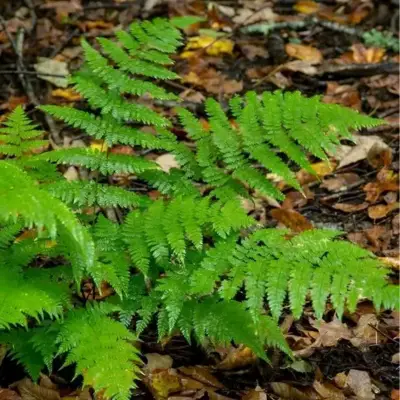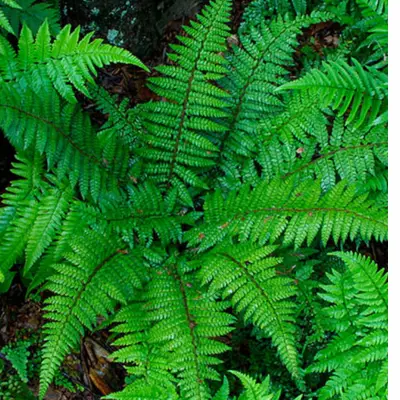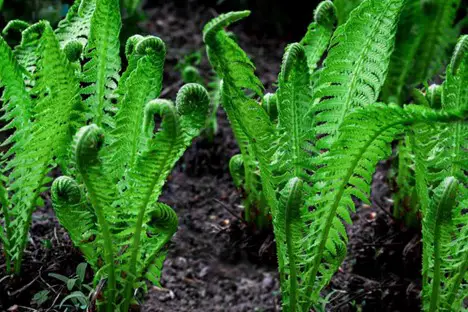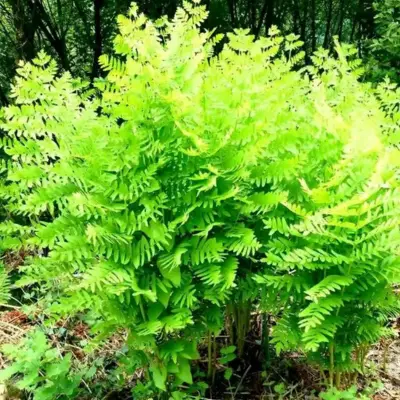Top 6 Ferns for Beautiful Borders: Adding Lush Greenery and Texture Ferns are a classic addition to any garden landscape, particularly along borders where they can add a sense of lushness, depth, and delicate texture. Among the few species of plants that don’t flower are ferns. They reproduce using spores, which are found underneath their leaves. They range in size from a few inches to six feet and are available in different shades of green. Their elegant fronds and varying shades of green bring a touch of the wild to even the most meticulously tended gardens. With so many fern varieties, choosing the right ones for your borders can be overwhelming. Let’s explore six top fern choices that are both visually stunning and relatively easy to incorporate into your garden borders, along with tips from TN Nursery on how to care for them:
1. New York Fern (Thelypteris noveboracensis)

The New York fern is a deciduous plant thrives in moist, shaded areas. Its delicate, light green fronds have a distinctive shape and grow clumping, making it an excellent choice for filling gaps along borders. It displays a beautiful yellow hue in the fall before returning for winter. Their airy, delicate appearance adds a sense of lightness and movement to borders and arrangements, creating a dynamic visual contrast.
- Hardiness Zones: 3-8
- Light: Partial to full shade
- Soil: Moist, well-drained
- Height: 1-2 feet
- Spread: 1-2 feet 2.
2. Christmas Fern (Polystichum acrostichoides)

The Christmas fern is a timeless classic for its evergreen nature. Its glossy, dark green fronds add year-round interest to borders. It has shiny, leathery fronds that emerge in a distinctive shuttlecock pattern, gradually unfolding into a graceful vase-like shape. This fern gets its name from its ability to retain its foliage throughout winter, resembling miniature Christmas trees. You can add lasting color with this low-maintenance option. Their deep green hue provides a striking backdrop for seasonal blooms and adds year-round interest to garden borders.
- Hardiness Zones: 3-9
- Light: Partial to full shade
- Soil: Moist, well-drained, slightly acidic
- Height: 1-2 feet
- Spread: 1-2 feet 3.
3. Hay-Scented Fern (Dennstaedtia punctilobula)

The hay-scented fern is unique for its sweet fragrance. His native North American species produces dense colonies of finely textured fronds, creating a lush carpet-like effect in garden borders it releases when its fronds are crushed. This ground cover spreads rapidly with delicate, lacy fronds, making it an excellent choice for covering large areas quickly. Just be mindful of planting it where it can apply without taking over. The airy foliage of these plants adds whimsy to border plantings and complements a wide range of companion plants.
- Hardiness Zones: 3-8
- Light: Partial to full shade
- Soil: Moist, well-drained
- Height: 1-3 feet
- Spread: Can spread indefinitely
4. Lady Fern (Athyrium filix-femina)

The lady fern is beloved for its graceful, arching fronds and vibrant green color. It’s a versatile option that adapts to various light and soil conditions. Several cultivars of lady fern include the elegant ‘Victoriae’ with its crisscrossing fronds and the silvery-purple Japanese-painted fern. It is valued for softening hard edges and creating a sense of gentle movement in garden borders.
- Hardiness Zones: 4-8
- Light: Partial to full shade
- Soil: Moist, well-drained
- Height: 1-3 feet
- Spread: 1-2 feet
5. Ostrich Fern (Matteuccia struthiopteris)

The ostrich fern is spectacular with its large, vase-shaped fronds that resemble ostrich plumes. Native to North America, Europe, and Asia, this vigorous species forms large, vase-shaped clumps that add vertical interest to garden landscapes. It makes a striking statement in any border as one of the tallest fern species. It prefers moist environments and spreads quickly, making it an excellent choice for larger spaces. Their dramatic form and vibrant green foliage create a focal point in any planting scheme, whether used as standalone specimens or combined with other shade-loving perennials
. • Hardiness Zones: 3-7
- Light: Partial to full shade
- Soil: Moist, well-drained
- Height: 3-6 feet
- Spread: 2-4 feet
6. Royal Fern (Osmunda regalis)
Undoubtedly, the Royal Fern (Osmunda regalis) is one of the most magnificent and regal plants on the planet. This plant has long, arching fronds that reach a length of six feet and are a deep green color. Royal ferns prefer acidic, damp soil in partially to wholly shaded areas. In the fall, the Royal Fern’s fronds can turn a brilliant golden-brown hue, enhancing your landscape’s visual appeal. There is no need to routinely water the Royal Fern since it loves consistently moist soil.
Spring fertilization with balanced, slow-release fertilizers can make a world of difference. Dead fronds should also be removed in the spring. Royal Ferns are an excellent option for dramatic statements in your garden or landscape.
Tips for Growing Ferns in Borders
- Provide Shade: Most ferns prefer partial to full shade; check the preferences of your chosen varieties.
- Rich, Moist Soil: Ferns thrive in well-drained soil rich in organic matter.
- Mulch: Maintain soil moisture and suppress weeds with a layer of mulch.
- Watering: Water regularly, especially during dry periods.
- Division: Divide overgrown ferns every few years to maintain their shape and vigor.
The Timeless Beauty of Ferns:
You can plant many ferns on your border, some of which are perennial and some of which are evergreen. Combining your ferns with other shade-loving plants will also create a stunning effect. With their diverse textures, colors, and forms, these ferns create attractive, low-maintenance garden borders. Their tolerance for shade is an invaluable asset for creating lush oases in often overlooked areas of your landscape. These fern species provide enduring beauty and low-maintenance appeal for gardeners seeking to create stunning borders that delight the senses throughout the year, whether used as focal points, accents, or ground covers.
Final Remarks:
By incorporating these exceptional ferns into your borders, you can elevate your garden with their timeless beauty, diverse textures, and captivating colors. These hardy native ferns will elevate your gardening game! These ferns can flourish and remain impressive for many years if you follow their straightforward care instructions. Instead of opting for a dull garden, how about a fern-tactic one? Get started with your planting today! Let me know if you’d like additional fern varieties or a more focused discussion on planting and care. Happy Gardening!

